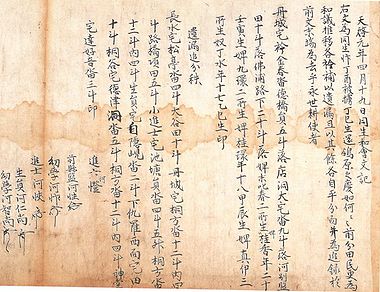Record of Property Distribution among Brothers from 1621
| Primary Document | |
|---|---|

| |
| Title | |
| English | Record of the Property Distribution among Brothers from 1621 |
| Chinese | 天啓元年四月十九日, 同生和會文記 |
| Korean | 1621년 하징 등 화회문기 |
| Document Details | |
| Genre | Social Life and Economic Strategies |
| Type | Record |
| Author(s) | Ha Tŭng? |
| Year | 1621 |
| Key Concepts | |
| Translation Info | |
| Translator(s) | Participants of 2016 Summer Hanmun Workshop (Advanced Translation Group) |
| Editor(s) | (Introduction) Martin Gehlmann |
| Year | 2016 |
Introduction
The Japanese Invasions of the Korean Peninsula between 1592 and 1598 not only brought enormous economical costs to Chosŏn Korea, i.e. through the loss of arable land, but also saw an unprecedented displacement of its people. About fifty to sixty thousands prisoners were taken to Japan, where most of them worked as slaves or were further sold to European traders.[1] However, as many prisoners brought with them the culture, skills and trades of their hometowns, their forced exchange led to a substantial transfer of knowledge. Just like Japanese prisoners of war had spurred the development of firearms in Chosŏn and Ming China, Koreans brought new techniques of ceramic production and knowledge of Neo-Confucianism with them to Japan. While in the negotiations between the Chosŏn court and the Japanese after the war the repatriation of all the prisoners was demanded, only the return of 7.500 Koreans is documented. [2]
The absence or loss of family members often presented families in Korea with the dilemma of having to rearrange succession and with it property distribution amongst the remaining family members in a state uncertainty. As Chosŏn was a predominately agrarian economy land was the most valuable property. While formally all land belonged to and was taxed by the King, increasing amounts of land were held in private ownership, mostly by Yangban families employing slaves and servants to work to fields. These families often drafted records of property distribution, in order to legally document the transfer of land to the next generation and to prevent disputes among later generations.
The following two records of property distribution document the serendipitous case of the Ha clan from Chinju, in modern day Kyŏngsangnam-do. Both documents have most likely been drafted by Confucian scholar Ch'angju Ha Tŭng (滄州 河憕) and concern his younger brother named Ha Pyŏn (河忭).
- View together with Record of Property Distribution among Brothers from March 11th, 1601.
Primary Source Text
| English | Classical Chinese |
|---|---|
|
The document mentioned on the right is as follows. Our brother Pyŏn, who was captured in the chŏngyu year [and held captive in Japan in 1597], returned [to Korea] alive in the Chŏngsa year [1617]. Rejoice at our brother’s homecoming! [3] As for the lands and slaves we had previously divided up, now we convene again to redistribute them to everyone and also make up for omissions. As for the remainder, we divide it up fairly. This will be attached as an addendum to the earlier document, so that the lands be tilled and the slaves be managed in perpetuity. |
右文爲, 同生忭, 丁酉被擄, 丁巳生還, 鴒原之慶, 如何如何 前分田民, 更爲和議, 推移各衿, 補以遺漏. 且以其餘, 各自平分. 而幷爲追錄於前文末端爲去乎, 永世耕使者 |
Discussion Questions
- View together with Record of Property Distribution among Brothers from March 11th, 1601.
- The family decided to distribute the property while a brother is still in Japan, Why?
- What does this tell us about the importance of property division for families and individuals? Why is this so?
- What do these documents tell us about the way family property was evaluated and divided?
Further Readings
References
- ↑ See Arano Yasunori, The formation of a Japanocentric World Order, The Wako and Change in East Asia, in: International Journal of Asian Studies, Vol. 2 No.2, 2005, p. 197 f.
- ↑ See Kim Haboush, JaHuyn; Robinson, Kenneth R. (Ed.) A Korean War Captive in Korea 1597-1600. The Writings of Kang Hang, New York, Columbia University Press 2013, p. IX.
- ↑ Lingyuan (鴒原) is water birds. They are traditionally known to care for their siblings. Their being in the field signified a dangerous situation, since it is not their natural habitat. See, the “Chang Di” in the “Minor Odes of the Kingdom” in the Book of Odes: 《詩‧小雅‧常棣》“脊令在原,兄弟急難”